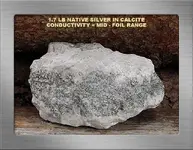Thanks to everyone for taking a moment to post your comments…each is very much appreciated. I’m quite pleased that fellow members seemed to have enjoyed reading the article.

Windage…lets address your questions. A sample’s benchtest conductive readout results from its physical / chemical make-up. Silver purity, types of mineral inclusions, structure, size, shape, the presence of iron minerals within an ore structure…all impact target ID…and there may be other factors as well.
In-situ…ground conditions play an extremely important role. Ground moisture content, strength of non-conductive magnetic susceptible iron mineralization, disturbed ground conditions, and the ore’s profile presented to the coil…all impact target ID. These factors can result in good silver even reading down into the iron range despite a specimen's physical / chemical make-up.
Silver ores in this area are associated with variable amounts of antimony, bismuth, very minor mercury, cobalt, nickel, arsenic, iron and other minerals. Minor inclusions of such minerals degrade silver’s electrical conductivity to a far greater degree than their compositional percentage might seem to indicate. The bulk of silver ores found by hobbyists are low conductives that target ID from low foil to mid-pulltab range. The maximum conductivity of natural silver in this area is at the silver dime category. The percentage of ores that fall into higher conductive ranges above the pulltab level dramatically declines as conductivity increases. It was happenstance that the specimens presented above were mostly higher conductives. Below is a small
low conductive specimen recovered this past autumn...




 Breezie
Breezie




